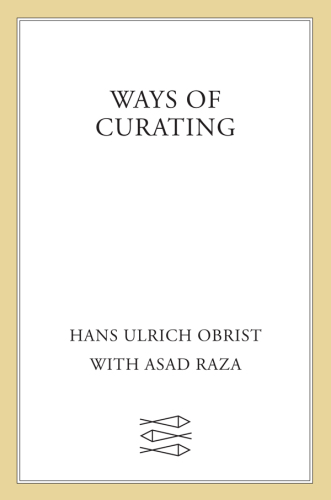
Ways of Curating
کتاب های مرتبط
- اطلاعات
- نقد و بررسی
- دیدگاه کاربران
نقد و بررسی

Starred review from July 28, 2014
With more than 250 shows to his credit, art curator, critic, and historian Obrist (Ai Weiwei Speaks), a director at London’s Serpentine Galleries, is an international force. His latest book provides an accessible and entertaining consideration of curatorial practices, in which the author describes the museum experiences, meetings with artists, and exhibitions that have most influenced his thinking, while occasionally touching upon the broader history of museums and exhibitions. Of course, because Obrist is responsible for some of the most game-changing exhibitions in recent decades, the line between personal history and general art history is thin. Obrist collaborates with cultural figures ranging from artists Félix González-Torres and Gilbert and George to the architect Cedric Price and the writer Doris Lessing. However, rather than name-dropping, his insistence on collaboration reflects one of his overarching themes, namely his “belief... that curators follow artists, not the other way around.” Despite his considerable influence, Obrist doesn’t fit comfortably into the mode of curator-as-artist that increasingly dominates the marketplace, but instead turns, with respectful deference, to the work of others. Biennials excite him because they might be a “spark or catalyst for something else in the local scene,” while the best shows highlight history as well as the present. Obrist educates and delights, with the simple goal of sharing his life’s joy.

September 1, 2014
An acclaimed curator reflects on how, and why, we look at art. When he was a teenager, Obrist (Ai Weiwei Speaks, 2011, etc.) asked artists Peter Fischli and David Weiss, whose witty, irreverent works he had seen at Kunsthalle Basel (Switzerland), if he could visit their studio. That visit, writes the author, "became my eureka moment." Now, having curated 250 exhibitions-his first housed in his own kitchen-Obrist offers insights on art, artists and the meaning of curation. "There is, currently," he writes, "a certain resonance between the idea of curating and the contemporary idea of the creative self, floating freely through the world making aesthetic choices of where to go and what to eat, wear, and do." For Obrist, though, the role of curator is specific to art-"the curator has to bridge gaps and build bridges between artists, the public, institutions and other types of communities." The curated space, though, need not be within a museum or gallery: Obrist has mounted exhibitions in a hotel restaurant and monastery library, and he conceived "a mobile platform" within a museum that functioned as "a kind of public laboratory" for installations in unexpected places-a stairwell, for example, or the museum's offices. He also experimented with a portable museum consisting of a small picture frame that could be carried around and displayed. This Nano Museum "came to symbolize the idea that museums might one day disappear from our lives." Indeed, one artist scheduled to exhibit in the tiny space lost the frame. Besides reflections on curating, Obrist writes about some of his aesthetic heroes, including critic and anarchist Felix Feneon, collector and Ballets Russes founder Serge Diaghilev, and writer Robert Walser, a favorite of Kafka's. A succinct, personal perspective on the intellectual sources and enthusiasms of a distinguished figure in the contemporary art world.
COPYRIGHT(2014) Kirkus Reviews, ALL RIGHTS RESERVED.

November 1, 2014
This slim volume, a memoir of a sort, describes the (self-) education of a curator. The author introduces us to the numerous artists, critics, and thinkers who inspired him to follow his career path. Swiss-born Obrist is one of a generation of curators who have defined a more expansive role for these hitherto behind-the-scenes professionals. He and his forward-thinking colleagues have introduced creative, diverse, and inventive ways for audiences to experience art, broadened the venues where art is shown, and have partnered with artists to seek collaborative ways of working, all themes discussed here. Obrist sees curators as 21st-century salon hosts who conceive "contexts for things to happen," link people and ideas across the globe, and organize exhibitions that aspire to "create their own reality," not just illustrate ideas. The writing shines with the author's intelligence and curiosity, but one wishes he had designed a book with a format comparable to the novel approaches he has used so effectively for exhibitions. This will rightly become a standard source in the museum field, but it misses an opportunity to engage a broader readership. VERDICT An essential title for museum professionals, curators, and students aspiring to these professions.--Michael Dashkin, New York
Copyright 2014 Library Journal, LLC Used with permission.

























دیدگاه کاربران